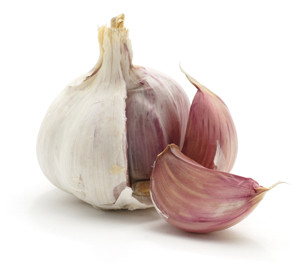IPM/Natural Gardening
Integrated Pest Management (IPM) is an arsenal of pest control strategies that minimize health risks to both humans and the environment. IPM is based on scientific research and focuses on long-term pest prevention by natural management of the ecosystem.You can practice IPM in your own garden by learning these six principles:
- Acceptable pest levels: IPM aims to control pest populations, not to wipe them out completely. Attempts at eradication usually leave some survivors who pass their resistance on to a new generation, increasing selection pressure for resistant super-bugs. When you nuke garden pests, you may end up creating a Godzilla.
- Monitoring: Keeping an eye on your garden ensures that pest control measures will only be used when necessary. When a pest is correctly identified, you can tailor the control method to the threat.
- Preventative cultural controls: The right plant in the right place means healthier plants with fewer pests. Waterlogged soil can make for weak roots and weedy beds. Swap the wa- ter-hogging plants for those adapted to local conditions. Healthy soil also helps support healthy, pest-resistant plants.
- Mechanical controls: The first line of defense against pests should always be mechanical controls: pick ‘em and squish ‘em! Got weeds? Hand pull or block their sunlight with mulch!
- Biological controls: Using nature’s own defenses is more cost-effective and environmentally safe than synthetic pesticides. Got aphids? Release ladybugs into your garden! Biological insecticides, such as Bt. bacteria and nematodes, are also effective biological controls.
- Responsible use: Synthetic pesticides are only used as a last resort within IPM, targeting specific times in a pest’s life cycleso environmental exposure to these pesticides is limited.
For more information on IPM practices visit UC IPM.
The Gardening Guide for Natural Gardeners
The Bay-Friendly Landscaping & Gardening Coalition Is a nonprofit organization that promotes sustainable landscaping and gardening practices in the San Francisco Bay Area. The Coalition encourages practices that reduce waste and pollution, conserve natural resources, and create vibrant landscapes and gardens.
The primary goal of Bay-Friendly is to lessen the impact of conventional landscape practices on the environment by providing home gardeners, landscape professionals, and local governments with the knowledge and resources to create beautiful, healthy, and sustainable gardens and land- scapes.
To learn more about natural gardening download this free guide.
Healthy Yards and Gardens: Control Garden Pests naturally
Natural pest control is safer than using pesticides. It’s safer for your home, your garden, your family and the environment. It’s also less expensive!
Did you know that homeowners in the U.S. use approximately 3x the amount of pesticides as farmers? U.S. homes use approximately 136 million pounds of pesticides on lawns, gardens and in the home. Think about what this is doing to our waterways. Rains and heavy winds transport these pesticides into storm drains which end up in our delta, creeks and streams.
An ounce of prevention is worth a pound of toxic pesticides.
Discouraging pests from coming to your garden in the first place is the easiest way to prevent insect damage:
- Pull out weak plants. They attract pests. Pull the plant and dispose of it.
- Compost and mulch. Natural composting and mulching helps develop strong, vigorous plants.
- Seaweed mulch or spray. Seaweed contains trace minerals (iron, zinc, barium, calcium, magnesium, etc.) which help build healthy plantlife. Seaweed gives plants the strength to withstand disease and repels slugs.
- Keep foliage dry. Wet foliage promotes insect and fungal damage. Consider drip irriga tion which delivers water to the root system of your plants, leaving the foliage dry.
Here are some preventative measures from eartheasy.com that you can take in your garden.
Home-made Remedies
Mites, Ahpids, Mealybugs: Mix one tablespoon canola oil and a few drops of Ivory soap into a quart of water. Shake well and pour into a spray bottle. Spray plant from above down, and from below up to get the underside of the leaves. The oil smothers the insects.
Pest infected plants:
Organic Garden Pest Control Recipe #1
- 1 head of garlic
- 1 tablespoon dish soap (Note: do not use a dish soap that contains bleach)
- 2 tablespoons mineral or vegetable oil
- 2 cups water
Peel the garlic cloves and puree the cloves along with the oil and water. Allow to sit over night and then strain the mixture. Add the soap and mix toughly. Pour into a spray bottle and use on pest infected plants.
Organic Garden Pest Control Recipe #2
- 1 tablespoon vegetable oil
- 2 tablespoons baking soda
- 1 teaspoon dish soap or Murphy Oil (Note: do not use a dish soap that contains bleach)
- 2 quart of water
Combine ingredients and pour into a spray bottle. Use this organic bug spray for plants on your affected plants.
Organic Garden Pest Control Recipe #3
- 1/2 cup chopped hot peppers (the hotter the better)
- 2 cups water
- 2 tablespoons dish soap (Note: do not use a dish soap that contains bleach)
Puree peppers and water. Let sit overnight. Strain carefully (this will burn your skin) and mix in dish soap. Pour into a spray bottle and spray this organic bug spray for plants on your buggy plants.
BEFORE USING ANY HOMEMADE MIX: It should be noted that anytime you use a home mix, you should always test it out on a small portion of the plant first to make sure that it will not harm the plant. Also, avoid using any bleach-based soaps or detergents on plants since this can be harmful to them. In addition, it is important that a home mixture never be applied to any plant on a hot or bright sunny day, as this will quickly lead to burning of the plant and its ultimate demise. For more information visit gardeningknowhow.com.
Don't Be a Pest to Our Creeks!
Use Integrated Pest Management to Keep Streams Running Clean
Kirker Creek, flowing less than a mile from here, has been impaired by the presence of a class of insecticides called pyrethroids, which harm beneficial insects like bees and dragonflies. When dissolved in the creek, pyrethroids are toxic to fish and lethal to mayflies, gadflies, and other insects that form the base of aquatic food webs. Not only do pesticides poison our creek, they starve it, too!

Mayflies, gadflies and other insects form the base of aquatic food.
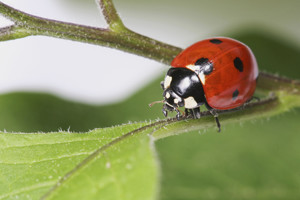
Release ladybugs into your garden at night.
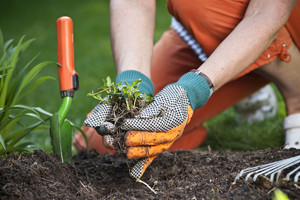
The right plant in the right place means healthier plants with fewer pests.
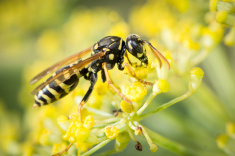
17 Fact Sheets for natural pest management
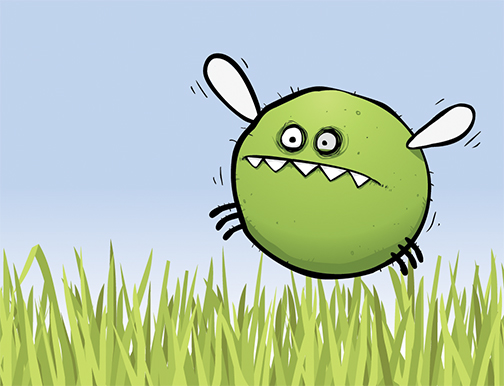
Seaweed prevents Aphids! Who knew?
